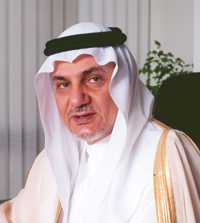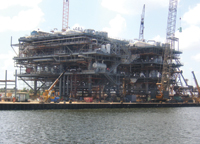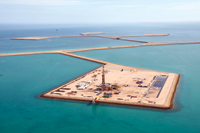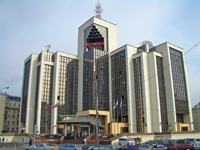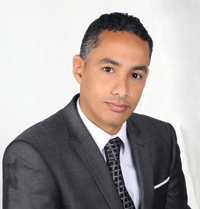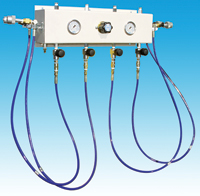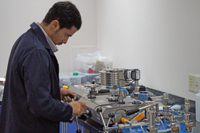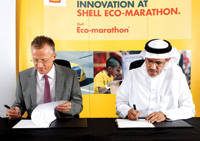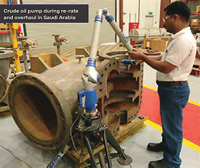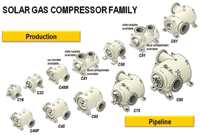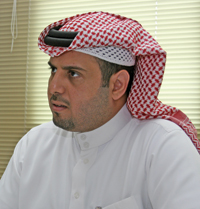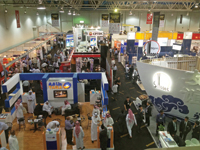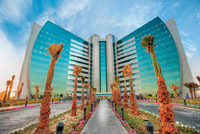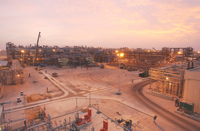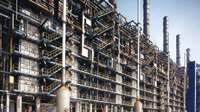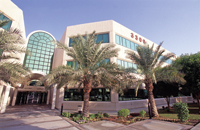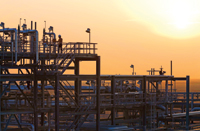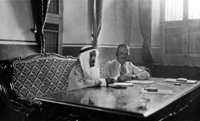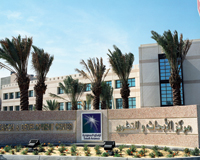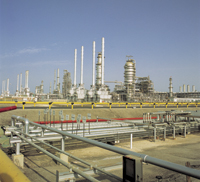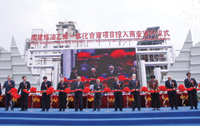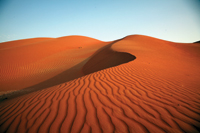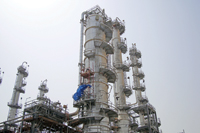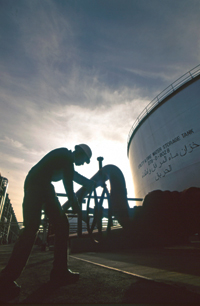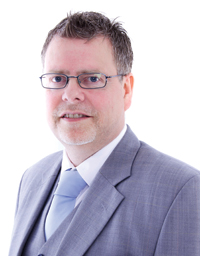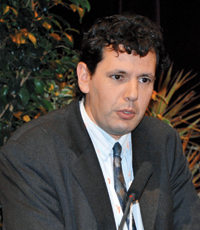
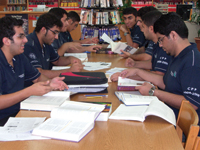 Saudi Aramco has placed top priority on spreading knowledge
Saudi Aramco has placed top priority on spreading knowledge
SAUDI ARAMCO is helping to develop the next generation of highly skilled workers and intellectually curious citizens. With more than 35 per cent of the kingdom’s population 15 years old and younger, the education challenge is now greater than ever.
Through training and professional development initiatives focused on science, technology, engineering and math (Stem) skills and the construction of the King Abdulaziz Centre for World Culture, Saudi Aramco is helping to build the kingdom’s knowledge base for the future, the company says in its 2012 Corporate Citizenship Report.
In recent decades, Saudi Arabia has invested heavily in educational infrastructure and providing higher education opportunities. Saudi Aramco dedicates significant resources and project management capacity toward developing an array of programmes and institutions aimed at advancing national educational ambitions.
This is part of Saudi Aramco’s legacy of investing in education, which started when Saudi Aramco opened its first school for Saudis in 1940. Building a knowledge-based economy requires creativity, cultural awareness and intellectual curiosity: Saudi Aramco’s flagship cultural initiative, the King Abdulaziz Centre for World Culture, will help Saudis connect their own culture to that of others around the world, serving as a catalyst for creativity and innovation.
The centre is designed to become a beacon of knowledge, creativity and cross-cultural engagement in the kingdom. It will offer a world-class museum, public library, historical archives, children’s educational centre, and conference and performance facilities.
Its iconic buildings continued to take shape in 2012 near Saudi Aramco’s headquarters in Dhahran. The following sections describe a comprehensive approach toward building a strong knowledge base in the kingdom.
In addition, Emerson, a global leader in technology and engineering, has announced it is planning to establish its own centre in the DTVC. To access best-in-class talent and strengthen collaboration in addressing technical challenges, Saudi Aramco’s subsidiaries are establishing international research centres in strategic locations around the world, including Delft, Aberdeen and Paris in Europe; Cambridge, Houston, Boston and Detroit in the US; and Beijing and Seoul in Asia.
These centres follow the first research centre established at King Abdullah University of Science and Technology (Kaust), which was tasked with undertaking projects related to biocapture, robotics, fuel technology, chemicals, membranes and advanced materials.
All of the centres are expected to be fully operational in 2013.
FOSTERING INNOVATION
Within Saudi Aramco, the company continues to strengthen and sustain a robust, creative and innovative organisational culture. The company’s state-of-the-art Idea Management System is paramount to administering the company’s innovation portfolio.
The system enables higher-quality ideas, improves idea tracking and reporting, and provides the platform for innovation campaigns. In 2012, the system captured 6,629 ideas submitted by 3,792 employees. A total of 547 were approved and 240 were fully implemented to achieve operational improvements and significant cost savings.
This year the company introduced targeted innovation campaigns, whereby organisations within Saudi Aramco can engage employees with specific business challenges. The company also continued its corporate-wide Innovation Tournaments in 2012.
The company’s most recent Innovation Tournament focused on improving stationary assets reliability and captured over 1,300 ideas. About 190 submissions have been shortlisted for further review and evaluation by subject matter experts, and the winners were awarded in early 2013.
In another effort to encourage innovation throughout the company, Aramco enrolled 300 employees in innovation courses and hosted 50 innovation awareness events. In 2012, Saudi Aramco pursued the commercialisation of three innovative technologies. The goal is to maximise profitability by capturing the value of the intellectual property, and contributing to Saudi Arabia’s economic development through the localisation of technology.
As a demonstration of its leadership in intellectual property in the kingdom, Saudi Aramco was granted 58 patents by the US Patent and Trademark Office in 2012, the most patents for the company in a single year.
 |
|
KFUPM ... nurturing talent |
Saudi Aramco filed 134 patents in 2012 and was able to reduce the time taken to file a patent to three months. Cumulatively, Saudi Aramco has been granted 218 patents, and has filed 460 applications that are pending.
Saudi Arabia plans to increase its global competitiveness – and as history has shown, economic success requires the active nurturing of innovation and creativity. Saudi Aramco believes and history has shown that innovation is necessary for enabling the kingdom’s economy and education systems to successfully compete on a global level.
The company took significant steps in 2012 to create new alliances and further develop existing ones that will help move the company and the kingdom toward becoming a leader in innovation, research and development.
Saudi Aramco is a strategic partner of KFUPM’s Dhahran Techno Valley Company (DTVC), located adjacent to the company’s headquarters in Dhahran.
DTVC plans to create a research and development hub in Dhahran, bridging the gap between academia and the energy sector. With more than 15 major companies currently operating in DTVC, it is quickly becoming one of the Middle East’s most influential industrial technology nuclei.
In December, the DTVC Board approved six key technology themes that will be the focus of its technology commercialisation efforts: advanced materials, geosciences and petroleum engineering, refining and chemical processes, water management, production and treatment, energy efficiency and renewable energy, and advanced computing.
In 2012, DTVC’s Science Park continued to attract leading companies with the inaugurations of several research and technology development centres. These inaugurations included the following centres:
• Honeywell, focusing on advanced engineering in catalytic processes and software development.
• Baker Hughes, furthering the understanding of the complex science and technology involved in developing unconventional resources;
• Rosen Saudi Arabia, developing new technologies in high-resolution quality defect identification, pipeline cleaning and intelligent robotic inspection; and
• Amiantit, researching composite and pipe technologies.
INVESTING IN EDUCATION
Tomorrow’s jobs will require highly developed Stem (science, technology, engineering and math) skills from today’s students.
Building a knowledge-based economy begins with investing in education. Saudi Aramco has a long history of investing in education, from childhood education through advanced degrees, particularly in science, technology, engineering and math disciplines. Encouraging Stem Skills In 2012, the Blended Learning Open Source Science or Math Studies (Blossoms) project was successfully completed with the development of 20 videos in math, physics, chemistry and biology.
Across the kingdom, 200 teachers completed training in 2012 on how to use the videos in their classrooms, bringing the total number of trained teachers to 400. There were 19,000 visits to the accompanying Blossoms website and its freely available video library containing over 50 math and science lessons.
Blossoms was developed in collaboration with the Massachusetts Institute of Technology and the Sultan bin Abdulaziz Science and Technology Centre. Saudi Aramco also collaborated with the Ministry of Education to develop an online educational tool called Mathletics.
With an Arabic interface and content based on Saudi Arabian math curricula, the website encourages students to challenge themselves by playing real-time games and puzzles, and by competing globally with other children.
Now in its second year, the Mathletics initiative has content available for first- and second-grade students. In 2012, about 4,200 students used the website in 100 schools. To encourage students to study math and science at university level, Saudi Aramco works to engage their interest early.
After a successful pilot in 2011, Saudi Aramco established 20 Math and Science Clubs in Dammam and Al Khobar in 2012, in collaboration with the Ministry of Education.
Instilling inquiry-based learning at an early age is critical to preparing students for scientific study later in life. In collaboration with the Ministry of Education and Siemens, Saudi Aramco launched the Siemens Science Discovery Initiative in 2009 to promote science education by sending “discovery kits” to kindergarten and first-grade classrooms in public schools.
The kits include scientific experiments on energy, electricity, environment and health. The goal of the project is to distribute 3,400 kits, train 2,000 teachers on inquiry-based learning and how to use the kits, and impact over 50,000 children.
In 2012, in the second phase of the project, the company distributed 1,100 kits, trained 606 teachers, and impacted 16,500 students in the Western Province. For the third phase, the company plans to implement this programme in the Central Province.
Saudi Aramco also sponsored the second class of the Saudi Research Science Institute, a six-week programme for high school students who conduct university-level research under the mentorship of Kaust professors.
In 2012, 40 high-calibre male and female high school students participated in the programme. In 2012, Saudi Aramco completed a project to translate and host TryEngineering.Org content in Arabic.
The website provides young people an opportunity to learn about career paths in engineering.
PROMOTING LITERACY
Saudi Aramco has historically supported literacy through the company’s mobile libraries, which visited 162 schools and distributed books to nearly 30,000 students in 2012. What is also required is a deeper understanding of how knowledge is acquired in the kingdom.
To better understand literacy rates and barriers to knowledge acquisition, Saudi Aramco began planning in late 2012 for the first nation-wide study of reading trends and patterns in Saudi society. The study will provide accurate statistics, recommendations, and tailored regional and national action plans that will be an important tool in supporting literacy and knowledge acquisition.
Saudi Aramco has historically invested in a number of vocational training institutes and higher education institutions.
In addition to the company’s strategic partnerships with the institutions described below, Saudi Aramco supports 14 university chairs across the kingdom:
• King Fahd University of Petroleum (KFUPM): Located adjacent to Saudi Aramco’s headquarters in Dhahran, KFUPM has been a key source of Saudi talent for decades. More than half of the company’s engineers and leaders are graduates of KFUPM. Saudi Aramco and KFUPM are strategic partners on research, teaching and professional training;
• King Abdullah University of Science and Technology (Kaust): Founded in 2007 and built by Saudi Aramco at the request of King Abdullah, Kaust is an international, graduate-level university located in Thuwal. Kaust currently offers advanced degrees in three areas: biological and environmental sciences and engineering; computer, electrical and mathematical sciences and engineering; and physical sciences and engineering;
• King Abdullah Petroleum Studies and Research Centre (Kapsarc): With its campus currently being built by Saudi Aramco in Riyadh, Kapsarc plans to push forward insight and understanding of energy challenges and to advance knowledge of efficient and sustainable energy production and consumption. Saudi Aramco and Kapsarc collaborate on a number of areas of research, particularly with regard to the kingdom’s energy initiatives;
• National Industrial Training Institute (NITI): Currently being built on land donated by Saudi Aramco in Al Hasa, NITI will offer industrial training mainly to high school graduates to qualify them for work in oil, gas, petrochemical and construction industries. The result of a strategic partnership between Saudi Aramco and the Technical & Vocational Training Corporation, it is expected to be completed in 2014; and
• Saudi Petroleum Services Polytechnic: SPSP supports the Saudisation of the oil and gas industry by producing well-qualified Saudi graduates who are highly trained in technical skills. As a main supporter of SPSP, Saudi Aramco collaborates on the development of curricula and provides hands-on learning opportunities.
INSPIRING YOUNG PEOPLE
Participation in a knowledge-based economy will require creativity, cultural awareness and intellectual curiosity.
In 2012, Saudi Aramco announced the visionary education programme iThra Youth, which seeks to reach and inspire 2 million young Saudis by 2020, as a complement to the company’s ongoing investments and initiatives in education.
iThra Youth is a key initiative of King Abdulaziz Centre for World Culture, striving to inspire young people to be lifelong learners, creative innovators and critical thinkers. The following extracurricular enrichment programmes serve this goal:
• iSpark: The flagship programme of iThra Youth, iSpark, offers interactive workshops to enhance knowledge in four modules: science, technology, art and multimedia, through partnerships with international institutions. During Saudi Aramco’s 2012 Summer Cultural Programme, 2,000 students completed 40,000 certified educational hours and produced 500 projects. The programme trained 100 teachers on how to use the modules. Through iSpark Mobile, an additional 10,000 Saudi youth across the Eastern Province took part in interactive workshops;
• iDiscover: Saudi Aramco has historically run math camps in winter for students and teachers, with 80 students and 12 teachers participating in 2012. Late in the year, the programme was revamped and rebranded as iDiscover and will include in 2013 a series of rigorous, creative and innovative science and math camps in Hail, Jeddah, Yanbu, Jazan and Al Hasa for both male and female students. iDiscover will offer hands-on and projectbased Stem programmes collaboratively designed by a network of global experts from the University of California Berkeley and Math Zoom; and
• iExcel: In 2012, about 2,400 students in 10 Saudi Aramco-built public schools in the Eastern Province participated in the iExcel programme. The programme covered topics such as safety, character building, health, art, recycling and environmental protection. The programme was introduced to girls’ schools for the first time in 2012.
In association with the King Abdulaziz and His Companions Foundation for Giftedness and Creativity (Mawhiba), Saudi Aramco hosted the 2012 Summer Gifted Programme (Aspire) for high-achieving Saudi high school students.
The programme focuses on maximising students’ intellectual ability, harnessing their abilities to serve community needs, and opening doors for them to explore a variety of academic fields.
In 2012, 104 male and 40 female students from public high schools took part in the programme.
The Saudi Aramco Cultural Programme inspires and educates millions of people each year and 2012 was no exception, attracting more than 1.5 million visitors in Dhahran, Riyadh and Jeddah.
The programme featured the first showing in the kingdom of the renowned international exhibit “1001 Inventions: The Enduring Legacy of Muslim Civilisation,” as well as an art café, a children’s theatre, outdoor performances, documentaries, traditional Saudi dancing, stand-up comedy, and a four-week certified workshop conducted by the National Youth Theatre of Great Britain for more than 100 local youth.
The hugely popular cultural programme was reprised during the Id Al Fitr holiday, which was attended by 662,000 people. Saudi Aramco also took the cultural programme to Al Hasa in the fall of 2012 for the first time, drawing about 400,000 visitors.
The cultural programme’s success was largely due to the efforts of 1,000 volunteers, who devoted a total of 200,000 service hours. Recruitment of these volunteers was aided in 2012 with the development of a unique volunteer website and recruiting management system, which was used by other Saudi Aramco volunteer programmes such as the company’s Mangrove Plantation Programme, beach clean-up days, the World Environment Day exhibition, and others.
The King Abdulaziz Centre for World Culture is designed to seamlessly meet a number of needs, all in one landmark building: a museum, a first of its kind library, a children’s zone, a learning centre, a theater and fluid exhibition and performance space.
Its iconic buildings are quickly taking shape near Saudi Aramco’s headquarters in Dhahran, and many of the programmes are already well under way. The flagship of Saudi Aramco’s cultural initiatives, the Centre is set to become a beacon of knowledge, creativity and cross-cultural engagement in the kingdom upon its completion in 2015. In 2012, the centre achieved significant growth in three key areas – the people, buildings and programmes that currently comprise the centre:
• People: The Centre’s staffing increased by about 22 per cent in 2012, bringing the number of dedicated staff to 109. Twenty-four additional employees were hired after an extensive recruitment campaign, and included communications professionals, researchers, library and archives experts, and exhibit fabricators. Professional development was also a priority, including seven internships with leading international cultural institutions;
• Building: Building the complex, multi-layered structure continued in 2012. Construction of the 300-foot tall structure reached 33 per cent completion, and is expected to be finished in 2015. The building’s unique gleaming façade – featuring 350 kilometres of stainless steel tubes – continued in fabrication with manufacturers in six countries; and
• Programmes: Exhibits and Galleries Extensive use of cutting-edge technology to engage visitors, enhance learning experiences and integrate cultural programming is one of the centre’s designed points of distinction. To meet this major goal, the centre is working with a leading multi-media technology creator to develop interactive technologies and experiences across 11 applications and multiple centre components.
In 2012, 90 per cent of the detailed design was completed, with fabrication expected in 2014.
LIBRARY AND ARCHIVES
Library and Archives collections and research efforts grew during 2012 through partnerships with the King Abdulaziz Foundation for Research and Archives (Ad Dara), the King Abdulaziz Public Library, the Saudi Commission of Tourism and Antiquities, and the Arab Thought Foundation, as well as through relationships with local and regional institutions and leaders.



















































































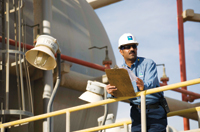
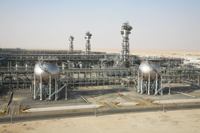
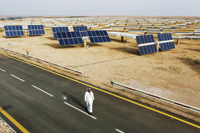

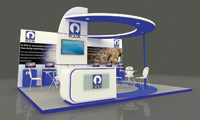
.jpg)
